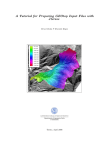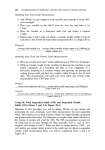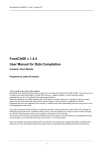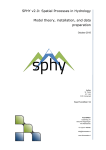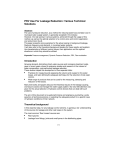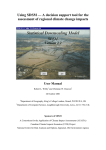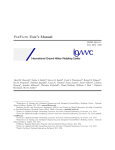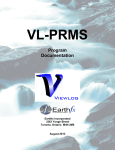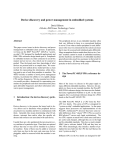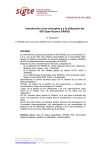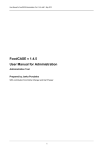Download Printer-friendly Version
Transcript
Geosci. Model Dev. Discuss., 4, C638–C675, 2011 www.geosci-model-dev-discuss.net/4/C638/2011/ © Author(s) 2011. This work is distributed under the Creative Commons Attribute 3.0 License. Geoscientific Model Development Discussions Interactive comment on “The JGrass-NewAge system for forecasting and managing the hydrological budgets at the basin scale: the models of flow generation, propagation, and aggregation” by G. Formetta et al. G. Formetta et al. [email protected] Received and published: 9 September 2011 1 General answers to the reviewers questions We would firstly like to thank all the Reviewers for their interesting comments and suggestions which will benefit the quality of our paper. As can be verified in the following and in the newly submitted manuscript, the paper has been greatly modified to satisfy the Reviewers’ requests. However, we have not added in-depth descriptions of the C638 informatics (infrastructure) system and of the modelling of other budget components (such as snow, energy); these are complex topic that require at least two separate papers (in preparation for submission to GMD) for their introduction and applications. There have been four main changes: • We decided to change the basin to which the model was applied because, as suggested by reviewers, in the case of the Passer river basin, firstly, the time series of measured data is too short and, secondly, snow is the main component of the water budget in winter and spring-time. Therefore, we moved to the Little Washita river basin, located in Oklahoma (U.S.), where the USDA provides twoyear long time series of discharges and detailed hydro-meteorological quantities. Also, the water balance of this basin is not influenced by snow. • We used the Priestley-Taylor model (Priestley (1959), Slatyer and McIlroy (1961), Priestley and Taylor (1972)) to assess evapotranspiration variability during the simulation years. Priestley-Taylor is just one of the models included in the JGrassNewAge System. It is a very simple model and parameter-parsimonious but it is adequate to the task required in the paper. • We decided to substitute for runoff production given by the Duffy model Duffy (1996b) with that given by the Hymod model ( Moore (1985) and Boyle (2001)). We were originally attracted by the conceptual simplicity of Duffy, but we realized that this did not correspond to a simplicity of application, since the parameter range provided in Duffy (1996b) is not extensible to catchments with different soil types and soil hydraulic properties. We could not, therefore, calibrate the runoff component model easily, given that the parameters kept fixed in Duffy’s original paper had to be calibrated and the model is not parsimonious.. On the contrary the Hymod runoff component has only five parameters, which can be calibrated automatically more appropriately. C639 • The fourth major change was, in fact, the introduction of an automatic calibration algorithm for the model. Specifically, we applied a mono-objective calibration procedure using the particle swarm optimization algorithm (Kennedy and Eberhart (1995), Eberhart and Shi (2001)). The calibration module is itself a reusable component of the JGrass-NewAge System. Furthermore, all minor typing errors have been corrected and suggestions from reviewers accepted; information about the features of the river basin and about the GIS udig-JGrass have been added as requested by reviewers. C640 2 Answers to P. Krause (Referee) (Q): Abstract: You mention that the system is able to estimate evapotranspiration (line 6) why don’t you use this in your model application. Same is true for snow modeling – not mentioned at all in the application part. Snow must be an important component in your catchment. (A): For the revised text the simulations were repeated and evapotranspiration was computed with the Priestley-Taylor model. Given that snow modelling requires detailed validation and because snow is an important component of the water budget for many months of the year at the Passer river basin, we decided to change the basin of study and use theLittle Washita river basin, Oklahoma (U.S.), instead. Therefore, the paper can concentrate on the presentation and analysis of runoff generation and propagation/routing components. (Q):Page 945, Line 5: ”whole set of hydrological quantities” is not very informative, please be more precise what you mean. (A): The sentence under review is: ”Models developed to reproduce a whole set of hydrological quantities for operational purposes came from water resource management and agriculture needs.” The sentence has been changed to: ”The water resource and river management required however the need to estimate a whole set of hydrological quantities (such as discharge, evapotraspiration, soil moisture) bringing very soon to the implementation of more comprehensive modeling systems, as the pioneering Stanford watershed model (Crawford and Linsley (1966)), or like the Sacramento model (e.g. Burnash et al. (1973)), the PRMS model (Leavesley et al. (1983))”. (Q):Line 29: Please indicate how you define “an acceptable degree of confidence” C641 (A):The sentence under review is: ”A solid paradigm of simpliïňAcation ˛ is offered by the theory of the geomorphological unit hydrograph, which provides ïňĆow values at a single point of the river network (i.e. at the outlet of the basin). In this case, many models with few parameters are able to reproduce the expected result with an acceptable degree of conïňAdence” ˛ The sentence was removed in the last version of the paper. (Q):Page 946, line 2, 3: I do not agree with the statement ”...the topology and the geometry of the river network is more important...” (A): The sentence is ”(e.g., Rinaldo and Rodriguez-Iturbe (1996)), in which the topology and the geometry of the river network is more important than the details of the local dispersive dynamics (e.g. Rinaldo et al. (1991)).” Besides Rinaldo et al. (1991), the statement is supported by the achievements of at least other two papers: Rinaldo et al. (1995), and D’Odorico and Rigon (2003), where it was shown that the form of the instantaneous unit hydrograph, as derived from the geomorphology, is mainly affected by the geometry of flow paths, both in hillslopes and channels. Further studies on the same subject were made by Snell and Sivapalan (1994), Saco and Kumar (2004), Botter and Rinaldo (2003). Coincidentally Mesa and Mifflin (1988) and Naden (1993), used similar models to forecast flow peaks. Furthermore, it should not escape attention that during a flood event some simplifications of the dynamics occur, as observed in the pioneering work by Leopold and Maddock in the 1950s. Anyway we removed the sentence in the last version of the paper. (Q):Line 4-6: Something is wrong with the sentence ”In addition...flow velocity”, at least I don’t understand what you try to say. (A): The sentence is ”In addition Leopold and Maddock (1953) observed that the overall action of hydrological and geomorphological forces act in maintaining approximately constant the ïňĆow velocity”. We dropped the statement in the revised version C642 of the paper, were we have stated that, during floods, the celerity of flood waves tends to be constant in space, as supported by the experiments of Leopold and Maddock, and others, and by some theoretical speculations Rodríguez-Iturbe et al. (1992). This statement allows us to conceive a simpler modellization of the flood wave, keeping this quantity, the velocity of flow in channels, fixed. (Q):Line 6: either “prediction is” or “predictions are” (A):Corretion accepted. (Q):Line 7-11: ”To this end...” – this sentence is too exclusive in my opinion. Of course RS provides very helpful information for spatial distributed modeling but it is not a ”must- must” as you indicate in your text. (A):The sentence was:” To this end it is necessary to make use of detailed information on topography (as derived from modern LIDAR or SAR sensors), and a large variety of remote sensed information, which provide new tools for representation of the physics of ïňĆow transport along the channels of the river network and processes into the hillslopes.” The sentence was removed in the last version of the paper. (Q): Line 17: “modification of model parameterisation” is not an innovative informatics as you indicate in your text. This possible and necessary with/for nearly every model that needs to be transferred and calibrated. The mentioned “modification of its parts” is more innovative but there are several modeling framework systems available (e.g. JAMS, OMS, TIME, MMS etc.) which provide such functionality. (A): This is the sentence on the paper: ” The JGrass-NewAge model (Franceschi et al. (2011)) was conceived and structured to meet these demands, to forecast not only ïňĆoods, but also of droughts, to calculate the water balance at several points in the river network of a basin, and to provide statistics revealing the internal C643 (spatio-temporal) variability of some of the quantities analyzed. To obtain this, the model implements innovative informatics, which is described in Antonello et al. (2011), to allow modiïňAcations ˛ of its parts and parameterizations without changing the whole, and therefore supporting the comparison of different schemes of simpliïňAcation, ˛ and of the parametrization of hydrological processes.” We agree with the reviewer. However, the sense of the phrase is given by "without changing the whole", and we, in fact, after having tried OpenMI, now use an existing framework, OMS3. The rationale of this choice will be explained in a companion paper, but can be summarised as follows: lower invasiveness of the framework in term of lines of codes (Antonello et al. (2011)), intrinsic parallelization of components, and the use of Java annotations to provide metadata about the model components. In fact, as explained in the paper, the informatics of JGrass-NewAGE use java annotations to automatically generate the graphic interfaces of the model components. Furthermore, this enhances the presence of a better community to support common developments. The fact that we did not "create" OMS3 does not means that it is not innovative. However, we believe that we have added value to it, making available OGC standards and a the "Spatial Tooolbox", now a standard component of the udig GIS (http://udig.refractions.net/), to OMS3 modelers . They are, we believe, an innovation within the innovation. We rephrased as follows: ”The JGrass-NewAge was conceived as an infrastructure able to offer a graphical interface to models without extra programming burden (Antonello et al. (2011) in preparation), and to reduce the gap between the production of new research and its deployment to stakeholders. For achieving this result, after testing alternatives, the OMS3 infrastructure (http://oms.javaforge.com), was chosen, having found in its concepts of programming by components, which allows to test different modeling strategies by changing parts of C644 a model at run-time (not at compiling time), a strategy either useful to research and to tailor modeling solutions to the requirement of a particular use case. To Jgrass-NewAGE, besides the OMS3 framework capabilities, we added the integration in a full featured geographic information system (GIS) system, udig-jgrass (http://udig.refraction.net and http://www.jgrasstools.net). In fact the new udig’s Spatial toolbox, which is freely available with the new version of the GIS, is largely an outcome of the research presented in this paper. Spatial toolbox aware/OMS3 components are able to deal with spatial coverages and features, according to the standards of the Open Spatial Consortium (OGC), as implemented by the Geotools (http://www.geotools.org), and work seamlessly inside the GIS within a user interface that is automatically created from the metadata present in any component’s source code appropriately programmed. Therefore the JGrass-NewAGE users have the possibility to mix compatible model components and create their own run-time model, and prepare and visualize the results inside the GIS system. This paper, however, does not talk about the core informatics that made it possible but has the goal to demonstrate that the strategy adopted is effective. Therefore we assembled some submodels into the JGrass-NewAGE, and with the paper we aim to demonstrate that this assembly is able to reproduce at best the discharges in a catchment. The model we structured out of the JGrass-NewAGE components was addressed to forecast the whole hydrographs at hourly time scale, to calculate the water budget at several points inside the river network of a basin and to give an estimate of the evapotranspiration.” (Q): The verb “confounded” might not really indicate what you had in mind. Think of a more proper word. C645 (A): The sentence was ”this concept could be confounded” The sentence is changed in ”this concept could be confused” (Q): From your description I get the impression that you are using nearly exactly the same semi-distributed approach SWAT is using. Maybe you like to refer that in your paper and discuss that a little bit. (A): We know SWAT. Our modeling effort can look similar in the objectives. But SWAT uses a daily time scale, while we would like to use an hourly time scale since the main characteristics of the response hydrograph are at a scale that is less than one day for most of basins up to some thousands of square kilometers,. (Q):Page 949, Eq. 3-6 and the following explanations: Please check very careful that you use the same indices and letters in text and equations. Right now it is a little bit confusing. (A): To better understand the meaning of each terms of the equations we suggest referal to Duffy (1996b) and Duffy (1996a). By all means, this model is no longer used in the simulations presented in this paper. (Q):Line 23-26: I wonder how you derive d1 to d4. Do you calibrate them? (A): We did not properly calibrate all of them, but we did consider values different from those proposed in literature (Duffy (1996a), Duffy (1996a)) to take account of the soil properties of the Passer river basin. These values were derived from the experience of one of the authors with the CUENCAS model. If we should need to calibrate all of these parameters, the task would easily become unfeasible. For this reason, in fact, we decided to use the HyMod model as the runoff production component in the revised manuscript, so reducing the number of parameters. (Q):Page 950, line 16: Ks in Darcy’s law is the saturated hydraulic conductivity - do you adapt it due to different saturations in your hillslope? Or do C646 you always assume saturation prior to runoff generation? What about e.g. preferential flow in macro pores? (A): No, we did not. But we could. We used a single, calibrated mean value for the whole catchment. If flow in macro-pores is Darcian then their contribution would raise the calibrated value. However, the Hymod runoff model uses different concepts. (Q):Line 18: As Ks is calibrated I wonder whether you use distributed parameters, i.e. different values on different hillslopes or do you have only one parameter for the entire model (catchment). If yes, how do you deal with different physical soil properties? Some more explanation on this would be interesting. (A): No, we used one Ks value which is constant throughout the Passer basin and equal to the value obtained from the manual calibration. Having more gauges we could calibrate the different parts of the basin differently. It is true that in principle we could have used pedotransfer functions or similar to associate an estimation of the hydraulic conductivity at saturation to any soil type (and/or land use). However, soil maps are not very reliable for Passer, at least for hydrological use, and the topics raised by their use require further care (see for instance Terribile et al., 2011 for similar trials) which would need research of its own. (Q):Page 951, Line 11: How do you determine the residence times for each hillslope? What are the controlling factors? Heading section 3 – use a large P for river Passer (A): We have changed model and we no longer use this scheme. However, residence time for each hillslope was determined using the geomorphic pathways determined as in D’Odorico and Rigon (2003) and jgrasstools modules (http://code.google.com/p/jgrasstools/). (Q):Page 952, line 14: north-east instead of nord-est (A): Corrected C647 (Q):Line 15 – 25: It is not explained why you derive and present all this information, describing topographical features. Where is such information used in the model? Please explain this or consider to omit it as irrelevant information. (A): Because we decided to change the river basin on which the model the question was applied, this is no longer relevant. By all means, we had added that information solely to describe the topographic features of the basin and they were not used in the model. In the new version this topographic information is not reported. (Q):Page 953, line 1 – 3: Why do use such short periods of only a couple of months? Is that a data problem? (A): The main problem was to avoid snow generated discharges which would have involved the need to explain in detail how the snow model works. In the new draft, the model has been applied to the Little Washita river basin where we used a two year long time series of discharges with an hourly time step. (Q):Line 6: Use sensitive or dominant instead of influential. (A): Done (Q):Line 9: Why didn’t you calculate ET a constant ET over a period of several months is not very likely. Here the question arises: Why do you get such a good model performance.If I assume that ET is something around 50% (just a guess, please correct me) or more of the precipitation amount in summer this should be relevant. (A): Prof. Krause is correct. In our new experiment we have decided to compute evapotranspiration using the Priestley-Taylor model. In practice this is another OMS3 component, also implemented in JGrass-NewAge, or, which is the same, in the jgrasstools. A more complete validation of this (and other) models remains, however, the argument of other incoming papers. C648 (Q):Line 15 ff: Something went wrong in the description and the figure legend. Now I am confused what is observed, what is simulated runoff. (A): We have redrafted the figure to make it clearer. In all the new figures, the gray dots represent the measured discharge and the solid black line represents the simulated one. (Q):Line 19 ff: I cannot really see the underestimation you mention. In the latter part of this paragraph that the underestimation of discharge is caused by an underestimation of rainfall. How do you make the spatial estimates, don’t you account for changes in elevation? And what about snow and ice processes could they be relevant for the underestimation as well? (A): The original spatial estimates of precipitation were made using a kriging with elevation drift (Ahmed and Marsily (1987)), one of the more used algorithms in mountain application. However, in the new simulations on the Little Washita river basin we have used an ordinary kriging to interpolate the precipitation data because the range of elevation of this basin is less than 200 m. While the snow melting and the ice certainly contributed to the underestimation of discharges in the Passer Valley, the problem is no longer present in the case of Little Washita. (Q):Page 954, line 20 – 21: Indeed you show that the model is able to show the hydrographs. But from fig. 9 I have the impression that the model is not able to calculate them correctly. All of them look awkward with that long recession dominating the entire hydrographs. Looks like a linear storage which starts with a large content and which continuously releases water without being replenished. Some discussion on that would be interesting and absolutely needed. (A): These problems are not anymore present in the new version of the paper. C649 (Q):Page 955, line 3: You should show us the parameters and you should try to explain which parameter is different and why. As you have stated earlier in the paper that the parameters have a physical meaning it is feasible to do so. Are you able to define one parameter set which works for both periods? Otherwise, the single periods might be overcalibrated. (A): We guessed that the parameters would be different since, for instance, in winter the soils of the higher parts of the Passer freeze, and the rainfall-runoff mechanism is completely changed (Dall’Amico et al. (2011)). In the new, two-year, simulations we calibrated the model with one year’s of data (2002) and validated it using the subsequent year’s data (2003). (Q):Line 4: You mention “structural model defects”. Firstly, I would call them structural model problems not defects. Secondly, please explain what problems you had in mind and maybe present solution how to solve them in the future. (A): We agree that "structural" model problems were due to the fixed parameter in Duffy’s model. We have solved these problems by changing the runoff model used to a more parsimonious model, where we could calibrate all the parameters. (Q):Line 9: What do you mean by the dependence of hydraulic conductivity from temperature? Do you think of frozen soils or what is it. Is this really relevant as you neglect the dependence of hydraulic conductivity from soil water saturation (maybe I got that point wrong, but then you should make it clearer in the paper). (A): The sentence in the paper was: ”Variation of parameters between summer and winter which was necessary to obtain reasonably good results, can be considered as a consequence of variation of hydraulic conductivity (depending on temperature), neglecting evapotranspiration, and outïňĆow from glaciers, which were kept constant, in C650 the present work, since there was no way to assess their inïňĆuence with measures”. We meant that, neglecting some processes that are known to vary between summer and winter, affected the (remaining) parameters values. However, the point about saturated/unsaturated conditions raised by the Reviewer was correct. In the revised version, we used a basin with no ice or snow, and we introduced an explicit modeling of evapotranspiration. The phrase above has been eliminated from the revised text. C651 3 Answers to K. Suprit (Referee) (Q):1. In the title “The models” should be changed to “a model” or “models” (authors may decide which one is more appropriate here). Also it is easier for the readers, if same order is maintained in headings (in the text) along with consistent use of terminology (in section 2; replace “runoff production, aggregation, and routing” with ’generation, propagation/routing, and aggregation’ and accordingly modify the subsection heading 2.2). (A): Suggestion accepted. The title will be: ”The JGrass-NewAge system for forecasting and managing the hydrological budgets at the basin scale: models of ïňĆow generation and propagation/routing”. In the new version of the paper we decided to follow a more classical structure for the title of each stections in order to take in account of the reviewes suggestions. Abstract, 1)Introduction; 2) Methods; 2.1) Basin delineation; 2.2) Rainfall and other Input data; 2.3) Runoff generation; 2.4) Flow Routing; 2.5) Evapotranspiration; 2.6) Parameters estimation; 2.7) Verification; 3) An Application to Little Washita (OK) river basin; 3.1) Results; 4) Conclusions (Q):2. This paper assumes that readers have a prior knowledge of “JgrassNewAge in- frastructure” from literature. Since the paper and manual referred to in the manuscript are in preparation, this is not essentially true. So, a little more detail in this regard is required (A): Even though the Jgrass-NewAge system itself is not the object of this paper, we have added some information about it at the beginning of the section 2: ”JGrass-NewAge is implemented within the udig GIS system, using its new spatial toolbox (which is an achievement partially generated by this project) based on OMS3, that permits the execution of any of the jgrasstools (http://code.google.com/p/jgrasstools/) with a proper C652 graphical user interface, as part of the GIS. All the jgrasstools modules are open source, distributed with source code under the GPL v 3.0 license, and programmed in Java, but modules written in C/C++ or FORTRAN could also be included. Besides the components written specifically for JGrass-NewAGE, the jgrasstools include basic (and less trivial) routines for digital elevation model (DEM) manipulation, basin related analyses, network related measures and geomorphological classifications, tools for hillslope analysis, and for performing DEM statistics. Finally, the jgrasstools contain other modeling efforts, such as SHALSTAB (Dietrich et al. (1992) and Montgomery and Dietrich (1994)), Peakflow (e.g. Rigon et al. (2011)), and others.” (Q):3. I get an impression that summer rainfall is 2-3 times more than winter (see the different ordinate scales in Fig. 7 (0-5 mm/h) and 8 (0-15 mm/h)), yet the highest discharge peak is seen in winter. It may be interesting for readers (who are not familiar with the region) to have some background of the physical and climatic setting of the basin along with observed intra-annual variability in precipitation etc... (A): We thank the reviewer for the suggestion. In the re-drafted paper we have given some background of the physical and climatic setting of the Little Washita basin, and discuss in more detail the data avaialble. Added: "The Little Washita river basin (611 square kilometers) is located in south west Oklahoma, between Chickasha and Lawton. The elevation ranges between about 500 meters and about 300 meters (Allen and Naney (1991)). The bedrock exposed in the watershed consists of Permian age sedimentary rocks and soil textures range from fine sand to silty loam (Allen and Naney (1991)). The climate in the basin can be characterized as moist and sub-humid, with a long-term spatially average annual precipitation of 760 millimeters and temperature of 16 degrees Celsius; winters are typically short, temperate, and dry but are usually very cold for a few weeks. Summers are typically long, hot, and relatively dry. C653 Regarding the runoff produced in winter time in the case of the Passer basin: we guess it is due to a combination of some snow-melting and the abrupt change in the coefficient of runoff after the soil freezes (e.g. Dall’Amico et al. (2011)). However, the confirmation of this will require further investigation and field work. (Q):Model calibration is done twice and reasons for that are introduced quite abruptly in the conclusion section. I was just wondering what will happen if you calibrate the model only once and simulate the discharge for the entire year? In this way, the rationale for calibrating twice can be explained more easily and earlier in the text itself. (A): The need for a double set of parameters in the original basin was generated by the presence of frozen soils in winter, that changed the runoff generation dynamics. This is one of the reasons why we changed the study basin and chose one with a more simple behavior. In fact, in the new simulations, we indirectly answer your question by using one year for the calibration period and one year for the validation. (Q):5. When an analysis is done (in section 3), I am not sure if the readers are provided with the purpose and conclusions derived. I feel the same with the simulation results; conclusions based on the simulations are not given in much detail. Even with one year of data, some interpretation can be made regarding further modification or addition in the system. (A): We have added the appropriate parts in the revised text, better explaining the meaning of the simulation, and enhancing the conclusions. (Q):6. Model details, especially the ADIGE components are given in detail, but they do not highlight what is new/ different from those used before. So in my opinion, details of the model should come first, then a comparison can be made with others, and not vice-versa. (A): What is different from the previous model is the assembly of the various model C654 components. The single parts, used to describe sub-processes, were in fact derived from literature and not “invented" here. However, the main novelty is that these components can be more easily interchanged than in the past, by just introducing the appropriate component and linking the new one to the others at run-time (as opposed to compiling time). This capability endows the JGrass-NewAGE system of great flexibility, and allows it to grow with knowledge of processes and basins without the need to rebuild the whole code. We thought the GMD the appropriate journal for the dissemination of this achievement, since it is said to be ”an international scientific journal dedicated to the publication and public discussion of the description, development and evaluation of numerical models of the Earth System and its components.” In fact, the use of the new informatics allows for seamless inclusion of the calibration algorithm based on particle swarming, without any modification to the rest of the code. In fact, the model with calibration and without calibration are two different assemblies of the same basic components, but using different Groovy scripting. (Q):7. There should be a separate subsection or at least a short paragraph about datasets (terrain, precipitation, etc.) used. It will be also good to discuss the data requirements of the modeling system. (A): We accept the suggestion. About the datasets used, we have added to the basin general information with more information in the section "Application". This part will also clarify the data requirements. (Q):8. Authors claim that the modeling system is built upon flexible components. This is not coming out clearly. The modelling system is built on Jgrass, an open source and free GIS. This point should also be highlighted. (A): We accept the suggestion and we have added this information in section 2, as this modification also was called for in answer to previous comments. (Q): Figures: Figures need considerable improvement. C655 Expand and check all captions carefully. Figures 7 , 8, 9 are hard to comprehend (especially the axes labels). (A): We accept the suggestions, and we have done our best to improve figure readibility. (Q):9. Check subscripts and dimensions in eqs (3–6). I guess As should be dimensionless. Please give the units of Ds. What about unit of A in eq. (13)? (A): To better understand the meaning of each term of the equations we refer you to Duffy (1996b) and Duffy (1996a). By all means, the Duffy model is no longer used for the simulations presented in the revised paper, for the reasons explained in answering the first Reviewer, prof. Krause . (Q):i. Figure 1 is nice. However, some improvement is required. Bigger arrows and more details embedded in the schematic will be appreciated.What does the right-most arrow depict? (A): The right-most arrow had the same meaning as f20 outgoing boundary flux on S2 . However the figure is not present in the revised paper. (Q):ii. Figures 2 and 5 can be combined together. 2 (or 5) can be used in inset. The intermediate positions of figure 9 can also be marked here. Also in Figure 2, please check: In caption outlet of Passer river basin is at Saltusio, but in the text it is at Bojen. (A): We set the entire model of the Adige river basin with outlet to Bozen (as we wrote in the text) but the sub-basin where we tested the model (calibrated and validated) is in the sub-basin with outlet to Saltusio (this is the Passer river basin). The motivation of this choice was the fact that the Passer river basin discharge is not affected by anthropogenic modifications (such as hydropower power-plants, artificial reservoirs). However, the Passer basin is not used in the new revised paper for reasons explained above. C656 (Q):iv. Figures 7 and 8 are crucial for the paper. Please be more careful in preparing them. Check the captions: dates on top of figure and in caption differ! Your representation of dates (x-axis label) seems to differ in both the panels. Ideally it should be date and month. Simulation not “ simulation data” is enough in caption. (A): We appreciate this suggestion and have modified the new figures accordingly. (Q):944(18-21): “The model has been tested.....modeled discharge” I am not sure what is meant by “scaling properties of discharge ”. Also, a statement regarding the results obtained (or nature of simulations) is missing. (A): We have deleted the sentences regarding the scaling properties because it is not a key point in this paper. Instead we have added information about the simulation period and the time step used in this paper. The sentence has, therefore, became: ”A two year simulation is presented at hourly time step, in the Little Washita (OK) basin. The model performances have been tested against measured discharges according to some classical indices of goodness of fit.” (Q):945(5-10): “in this context......and the PRMS model”. Needs rewriting. I am confused with the statement about “large modelling system”. Does it mean exhaustive data requirement or consideration of many processes? (A): The sentence has been changed: ”The water resource and river management required however the need to estimate a whole set of hydrological quantities (such as discharge, evapotraspiration, soil moisture) bringing very soon to the implementation of more comprehensive modeling systems, as the pioneering Stanford watershed model (Crawford and Linsley (1966)), or like the Sacramento model (e.g. Burnash et al. (1973)), the PRMS model (Leavesley et al. (1983)). They were usually based on the metaphor of intercommunicating compartments (reservoirs), each representing a process domain, each one with its residence time.”. C657 (Q):945 (20-21): As far as I remember, Beven (2001) does not talk only about lumped models. He discusses all types of models. Also check the reference style for distributed model references, ‘;’ is missing. (A): Correct, we have changed the phrase to avoid misinterpretations. We have also fixed the reference style. (Q)945 (25): “unnecessary” is not a proper word here as it gives a different meaning. Perhaps something like...” without representing the full spatial variability’.....would be better. (A): Correction accepted; the sentences have become: ”In the first class, the physics is modeled at grid (pixels) level using the fundamental laws of conservation of energy, mass, and momentum, in the second, the ruling equations are simplified in order to obtain some statistics of the hydrological budget without representing the full spatial variability of the processes. Simplification sometimes were derived by solid arguments, and in this context a solid paradigm is offered by the theory of the geomorphological unit hydrograph (e.g. Rinaldo et al. (1991), Rigon et al. (2011)), or by heuristic subjective arguments. .” (Q):945 (26- last para): It may read better if this paragraph is linked to the preceding paragraph...building from whether GIUH is lumped or distributed. (A): This paragraph is no longer part of the article because we have replaced the runoff generation component with the Hymod model. (Q):946 (7): “...discharge at intranet location” I got the meaning, but I wonder if a more suitable replacement for ‘intranet’ can be found. (A): We intented it is a word that gives the idea of "internal points of the network"; to avoid confusion, we have used this periphrasis in place of the word "intranet" in the revised text. C658 (Q):946 (10): “physics” not required. I am also not sure how remote-sensing provides new tools...it should be new data. (A): The sentence was removed in the new version of the paper. (Q):946 (12): “...floods and draughts...” Is it necessary to bring it here, without mentioning the speciïňAc ˛ spatial-temporal scales at which JgrassNewAge works? (A): We contend that it is necessary because it is not only a model capable of capturing flood events but it also captures droughts. This is also thanks to the propagation module of the generated runoff which, for instance, allows for water velocity to vary at each stage and is not, therefore, treated as a constant as is common in flow peak models. By all means, the temporal scale at which the model works is hourly or sub-hourly. (Q):946(25): “..Any HRU instead...” this statement seems vague. Also Hls are important here, so 2-3 lines can be devoted to explain how they are delineated. (A): Suggestion accepted. An explanation of the process of hillslope delineation was added in the revised text. (Q):947 (23): Title can highlight ADIGE: Jgrass.... (A): J-Grass-NewAge is the complete system, but the object of this paper is to present the ”Adige” component only, which includes the processes of runoff production, aggregation, and routing. (Q):947(25): “...Where L means a length such as mm...” something like... L is length (mm) C659 (A): L means a generic length unit; it can be mm or m according to the other unit of the terms appearing in the equations. We have made this more explicit in the new text. (Q):948(5): “...Differently form most of the models...” Is the model used different from above mentioned models only or some other models? Are there any similar models? (A): Because we changed the runoff generation component, this sentence was removed in the new version of the paper. (Q):948 (5): “...coupled and generate runoff. . .” meaning is not clear. (A): The sentence is ”The equations of the two reservoirs are coupled and generate runoff, while the runoff routing itself, is described by a simple distribution of residence times”. The term "coupled" refers to the method of solving the equations mathematically (i.e. they are solved as a system of equations). Once the system of equations has been solved, runoff is generated. (Q):950 (1-6): First line of this paragraph is quite abrupt. I think a re-organisation or rewrit- ing will make better sense. Actually the second sentence should start this section. (A): As suggested we have started with the second sentence. (Q):950 (10): “In this calculations...Darcy’s law average according...” sider rewriting. (A): Darcy’s law is not used in the new draft of the paper. con- (Q):951 (17): Eq. (13). Please check the dimensions. Is it (A) area or fraction of area? (A): It is the saturated fraction area, a fraction of the total area: dimensionless. (Q):952 (5): Menabde and Sivapalan (2001) missing from reference. C660 (A): Added. (Q):952 (Section 3 heading): “passer” to Passer (A): We accept the correction. (Q):952 (11): “...and shown in Fig...” delete. It is a good practice to avoid, as much as possible, usages such as...’shown in Fig’ or ‘as shown or given in Table’ ...etc. Figures and tables should be mentioned in parenthesis along with concerned statements. (A): For the new figures we have taken into account your suggestion. (Q):952 (18): “...Jgrass-NewAge infrastructure...” model or infrastructure or stat? Use consistent terminology. (A): We accept the comment. We use model or system through all the text. (Q):952 (19): “gemorphological” geo... (A):We have removed this part because it was not useful for the model - it served only to illustrate the geomorphological features of the basin. (Q):952 (20): If not given earlier, some reference for JGrass will be appreciated here. (A): We have added some information and citations about Jgrass at the beginning of section 2. (Q):952 (21): “The relationship area-perimeter” insert ‘ between’ . (A): We have removed this part because it is not essential (Q):952 (22): “In (Fig.4) it is...” It is.... (A): We have removed this part. C661 (Q):953 (20): Please be more clear how you arrive at this conclusion “where volume of discharge is considerable ‘lly’ greater than...precipitation...”. From the Figs 7 and 8, I can understand it for the winter peak, but for summer, I am not sure. One way to see it will be to compare areal precipitation with discharge. (A): The new simulations on the Little Washita show different dynamics. (Q):954 (8): some examples of “state-of-art models’ will be helpful here. (A): The sections in which results are presented and discussed were modified in order to satisfy the reviewers requests. As far this particular sentences, it was removed from the paper. We cited milestones in modeling throughout the whole new texts. (Q):954 (13): I am not sure, inferring this from statistics is valid, as there is only one peak in winter. Can you think of a physical reason, why the winter peaks are simulated better than summer peaks? (A): We were aware that the winter simulations needed more work and have, therefore, switched to a basin where these interesting, but challenging, characteristics are not present. (Q):954 (20): In the last paragraph, some more detail is required....It can be described as an advantage of the model. Also add an “and” between link and therefore (A): Suggestions accepted: the new last paragraph presents more details and we added the "and" between link and therefore (Q):954 (25): I am not sure if this conclusion follows from the text. sort of explanation is required. (A): In the new revised text we have changed the conclusions. Some C662 (Q):955 (5): Vague statement about rainfall measurement errors. Needs detailed statement. The point made in text can be repeated here. (A): We have removed these comments. (Q):955 (15): “...any link end...” Not clear. (A): We have removed these considerations from the paper. C663 4 Answers to S. Samanta (Referee) (Q):1. p. 946, ll. 12-19 – many modern hydrological models are able to simulate stream flow as a time series (i.e., not restricted to modeling ïňĆoods or droughts) and are able to provide estimates at various locations. Many process-oriented hydrologic models also employ component structures due to its various advantages and also use the concept of hydrological response unit. Therefore, these capabilities of the JGrass-NewAge model do not appear to be new or different. The authors should clearly convey the specific advantages of their model in comparison to models that have similar capabilities, instead of why these capabilities are important in the context of hydrological modeling in general, as currently done in the preceding paragraphs. Moreover, the ability to provide “statistics revealing the internal (spatio-temporal) variability of some of the quantities analyzed” is very imprecise, while the details of the “innovative informatics” are not readily accessible as the Antonello et al. (2011) is indicated to be in preparation stage. These should be explained in greater detail (A): Dr Samanta is certainly right to many respects, and we have tried to answer to his comments, and to avoid generic statements, in the new version of the paper (please see also answers to comments to the other reviewers). One fact is that all the above characteristics he mentions are usually not possessed by a single model but can be found spread in different models. As far as our effort is concerned, we have tried not to focus on a single model but on the possibility to change part of the model at run-time (not at compiling time) using the OMS3 infrastructure, about which appropriate documentation can be found at (http://www.javaforge.com/project/oms). This framework, in turn, was not developed by us, but we have add to it the ability to be integrated without problems in a full featured GIS system, udig-jgrass, of which information (and the source code) can be found at http://udig.refraction.net (whereas the models we are talking about are available at http://code.google.com/p/jgrasstools/). In fact, the new Spatial toolbox, which is freely available with the new version, is largely an outcome C664 of the research presented in this paper. Therefore the JGrass-NewAge users have, in principle, the possibility to mix model components and create their own run-time model, and prepare and visualize the results inside the GIS system. This paper, however, does not talk about the core informatics that made it possible (that actually, even if with scarce but increasing documentation, is freely available and open to inspection by researchers) but has the goal to demonstrate that the strategy adopted is effective. Therefore we assembled submodels into the JGrass-NewAge, and with the paper we aim to demonstrate that this is a very good way to reproduce the discharges in a catchment. To achieve these results we actually used the ability of joining components by adding to the model tools for the spatial distribution of rainfall inputs, tools for calibration (in this case the particle swarming algorithm"), and, added in the revised version of the paper, the model of Priestley-Taylor to estimate evapotranspiration. Discussions were made in the revised text about what happens if some of these tools are excluded, and, we think, this can be considered, besides the whole thing itself, a further original contribution. We believe that in doing this, we partially fill the gap between writing of scientific software and commercial practice which profitably uses the concept of object oriented programming. Again, object oriented programming is nothing new, but it has proven to be a successful tool in solving many issues connected with cooperative work of many. As objects (models, algorithms, and data) can be packaged in components, they can expose for reuse only their most important functions. Libraries of components can then be re-used and efficiently integrated across modelling efforts. Therefore, the modeling experience can exploit properties such as encapsulation, data abstraction, and inheritance which can greatly help towards better science, at least when code writing is the method. We think that the components presented in this paper can be improved with method, being able to single out the part of code responsible when simulations do not agree with computation (as we have done in substituting Duffy’s submodel). Besides, we C665 think we have given hydrologists a flexible tool which allows them to spend more time understanding the physics of the processes, rather than in other tasks. (Q): 2. p. 949, eq. 3-6 – Explaining the underlying physical concepts in more detail here (in terms of water balance etc. and linking eq. 1 and 2 concepts to these equations) would be useful for understanding the physical basis of the model. (A):These concepts are presented in the papers Duffy (1996b) and Duffy (1996a). Anyway as reported in the paper: ”The model is based on integration of the continuity equation over a hillslope control volume. This is made up of the saturated and unsaturated soil storage, with the water table serving as a moving boundary between these two storage volumes. The Reynolds transport theorem is used to relate local continuum equations for moisture to the system storages and ïňĆuxes, and the divergence theorem relates integrals of the spatial derivatives to integrals of the surface ïňĆuxes (see Duffy (1996b) for details).” The Reviewer should kindly notice that even we answer to the questions he raised on the Duffy’s model, we have changed it in the final revision of the paper. (Q): 3. p. 949, ll. 10-22 – The superscript 0 of S is not defined. Are S1 and S2 the same as S01 and S02? (A): No, they are not the same. S1 and S2 represent the volume of water in unsaturated and saturated soil fractions per unit area of hillslope; on the contrary, S01 and S02 are the residual storage volumes in unsaturated and saturated soil fractions per unit area of hillslope. (Q):5. p. 951, eq. 10, 11, 12 – Please analytically explain or justify the use of this simplification based on the use of mean and variance of residence times and how the mean and variance values are obtained. Are they simply calibrated values? If k and n are calibrated parameters, as indicated below eq. 10, then what is the significance of eq, 11 and 12? C666 (A): We have eliminated this part from the new manuscript. However, the residence time was conceived as a distance divided by a velocity. The distance was estimated by analyzing the structure of the paths in hillslopes following the drainage directions. The velocity was calibrated. (Q):6. p. 951, eq. 13 – How the terms of the right hand side are calculated and related to the terms in the preceding equations is not clearly shown. It might be better to give the expression used for calculating Qi(t) in addition to its derivative shown in eq. 13. Overall, the underlying mathematics used for integration or scaling from unit area of hillslope to HRU and ultimately stream discharge is not entirely clear to me as I seem to miss some calculation steps. Is it possible to describe the links between stream discharge and processes at the unit area and HRU levels more clearly? Consistent reuse of mathematical terms through the sequence of the equations would help in this regard. (A): As suggested by the Reviewer we have better explained, in the paper section Runoff propagation/routing, both the terms of the right hand side of the equation 13 and how they are related to the terms of the runoff generation component. We have also presented the expression used for calculating Qi(t) instead of its derivative, as suggested by the Reviewer. This is what we have written in the new section Runoff propagation/routing: “The flow generation model along hillslopes delivers discharge to the channel network conceptualized in the model as a oriented tree graph. For each link the continuity equation, as presented in Mantilla et al. (2006) is: i X dSi (t) h = Qgen (t) + Qtrib (t) − Qi (t) i = 1, 2, ...., H dt (1) trib where the Si (t) is storage in the link i-th at time t, H is the total number of network links, Qi (t) [L3 T−1 ] is the output discharge from i-th link, Qtrib [L3 T−1 ] is the flow of upstream links, Qgen (t), [L3 T−1 ], is the discharge generated of the hillslope of the C667 link in question. Under the hypothesis that the link has a rectangular x-section, so the width, w , does not change with time, the channel storage and the discharge can be expressed as: Si (t) = li · wi · di (t) (2) Qi (t) = vi (t) · wi (t) · di (t) (3) where vi (t), [L T−1 ], is the flow velocity, wi (t), [L], is the mean width of the link, di (t), [L], is the mean channel depth and lt , [L], is the link length. Combining the equations 2 and 3 gives Si (t) in function of Qi (t); finally, using the Chezy equation: v = C · R0.5 · i0.5 (4) b where v, [L T−1 ], is the mean velocity , C, [L0.5 T−1 ], is the Chézy coefficient , R, [L], is the hydraulic radius, and ib [-] is the bottom slope, Si (t) can be expressed as: 2 2 1 − 13 S(t) = Q(t) 3 · C − 3 · w 3 · l · ib (5) The left hand side of the equation 1 is expressed by the derivative of the equation 5. After some mathematical steps the equation 6 gives the non linear ordinary differential equation in the unknown Qi (t): h i X dQi (t) = K Qi (t) · Qgen (t) + Qtrib (t) − Qi (t) i = 1, 2, ...., H dt (6) trib The coefficient K Qi (t) is equal to: KQ = 1 1 2 1 3 · Q 3 · C 3 · b− 3 · l−1 · ib3 2 C668 (7) where C [L1/3 T−1 ] is the Chezy coefficient, b [L] and l [L] represent the width and average length of the link respectively, ib [-] is the average slope of the link, and Q [L3 T−1 ] is the channel discharge. For a more detailed discussion of the terms in Eq. (7) see Menabde and Sivapalan (2001) and Mantilla et al. (2005). " We hope that the concepts results more clear now. (Q):7. p. 952, eq. 14 – The definition of Chezy coefficient seems to differ between eq. 13 and 14. Qsp is not defined. (A): In the revised text, we have better specified the meaning of the variable. (Q): 8. p. 952, l. 16 – How the hypsographic curve is used in the model is not clearly explained. (A):The hypsographic curve is not used in the model. We have removed this part because it is not relevant in this application. (Q): 9. p. 952, ll. 19-20 - Please provide the details about the Passer river basin that is used in this analysis. (A): We accept the suggestion, in fact we have provided a short description of the main hydrological feature of the new basin Little Washita in the revised version of the paper. (Q)10. p. 952, ll. 21-25 – Include an explanation of how the area perimeter relationship, results of the linear regression (the relationship P ∼ A0 .489 is not linear), the mean and the variance mentioned here are used in the context of the model equations described before. The mean and variance mentioned in eq. 11 and 12 relate to distributions of residence times. If these two sets of mean and variance values are considered related, please include a justification for that. (A): We have removed this part because it is not relevant in this application. The perimeter has a non-linear relation with area because it is a fractal (e.g. RodriguezC669 Iturbe and Rinaldo (2001)) (Q): 11. p. 953, ll. 5-15 – Please mention which parameters were calibrated and which were kept constant along with the values used for the summer and winter simulations, so that their signiïňAcance ˛ may be clearly understood by the readers. As the model structure is process oriented, the calibrated parameter values and their differences between seasons may be interesting and informative about the system. In addition, many modern automatic calibration methods provide some advantages (e.g., uncertainty estimates) over manual calibration methods. Is there any specific reason behind choosing a manual method? (A):No, there was not a specific reason. In fact, in the new simulations we have used an automatic calibration system as specified in the general comment section. The calibrated parameters of the new runoff production component are now more clearly specified. (Q)12. Deficiencies in data (p. 953, ll. 19-24) and model structure (p.955, ll. 4-5) are cited as reasons for some systematic errors. Such errors are usually more informative for making modeling improvements compared to simple goodness of fit measures. I would suggest showing the systematic deviations more clearly, perhaps using a residual plot, and including a more thorough discussion of such deviations. (A): We agree with the observations and comments of the Reviewer. The data quality was another problem of the old watershed; in the new application on the Little Washita river basin, as you can see in the simulations, the quality of the data is better. For the new simulations we have adopted the suggestions of plotting of residual errors. However this plot needed to be commented, since small time shifts between the measured and simulated discharges cause in some events large differences which could be not very relevant. C670 (Q) 13. p. 954, ll. 23-25 – The idea of component based model structure is not new and its use for this model is not really demonstrated in this paper. Also, the details of the “informatics” structure are not described in the paper. Therefore, these may not be considered as conclusions from this study itself. Moreover, good fit to a specific data set may not be considered as sufficient validation of a model, in my opinion. How model predictions relate to the observations should be discussed in more detail prior to the conclusions. (A): In the revised version we have discussed the model prediction with more detail as requested. Certainly a good fit is not a sufficient condition: but a necessary one. (Q)14. p. 955, ll. 1-11 - The conclusions regarding structural “defects” and signiïňAcance ˛ of the differences in calibrated parameter values should be discussed in detail along with the results. The fact that evapotranspiration and glacier outflow were kept constant should be mentioned before reporting the results along with the values they were held at. (A): In the new simulations the evapotranspiration is not constant but computed using the Prestley-Taylor method and the snow, for the new basin Little Washita, is not a relevant component of the water balance. (Q) 15. p. 955, ll. 12-16 – I am not sure that the authors clearly demonstrate that these “statistics of simulation” are different or more reliable than other models or methods for doing so. (A): We do not believe that our model is better than others, but certainly a very good one. Actually an unbiased comparison is probably impossible. We have simply shown that the model fits the measures well. However, we do claim that in our framework a clean comparison can be made by changing the component under exam: which is much more difficult within traditional monolithically implemented (non component based) models. C671 (Q) 16. The captions for the figures should be more descriptive and understandable on their own, as far as possible. (A): We accept the correction and have modified the layout of the figures. C672 References Ahmed, S. and Marsily, G. D.: Comparison of geostatistical methods for estimating transmissivity using data on transmissivity and specific capacity, Water resources research, 23, 1987. Allen, P. and Naney, J.: Hydrology of the Little Washita River watershed, Oklahoma: data and analyses, ARS-US Department of Agriculture, Agricultural Research Service (USA), 1991. Antonello, A., Franceschi, S., Formetta, G., and Rigon, R.: The JGrass-NewAge System for Forecasting and Managing the Hydrological Budgets at the Basin Scale: the informatic structure, 2011. Botter, G. and Rinaldo, A.: Scale effect on geomorphologic and kinematic dispersion, Water resources research, 39, 1286, 2003. Boyle, D. P.: Multicriteria calibration of hydrological model, Ph.D. dissertation, Dep. of Hydrol. and Water Resour., Univ. of Ariz., Tucson, 2001. Burnash, R., Ferral, R., and McGuire, R.: A generalized streamflow simulation systemâĂŤConceptual modeling for digital computers, report, Joint Fed. and State River Forecast Cent, US Natl. Weather Serv./Calif. State Dept. of Water Resour., Sacramento, Calif, 1973. Crawford, N. and Linsley, R.: Digital simulation in hydrology Standford watershed model 4, 1966. Dall’Amico, M., Endrizzi, S., Gruber, S., and Rigon, R.: A robust and energy-conserving model of freezing variably-saturated soil, The Cryosphere, 5, 469–484, doi:10.5194/tc-5-469-2011, http://www.the-cryosphere.net/5/469/2011/, 2011. Dietrich, W., Wilson, C., Montgomery, D., McKean, J., and Bauer, R.: Erosion thresholds and land surface morphology, Geology, 20, 675, 1992. D’Odorico, P. and Rigon, R.: Hillslope and channel contributions to the hydrologic response, Water resources research, 39, 1113, 2003. Duffy, C.: A two-state integral-balance model for soil moisture and groundwater dynamics in complex terrain, Water resources research, 32, 2421–2434, 1996a. Duffy, C. J.: A Two-State Integral-Balance Model for Soil Moisture and Groundwater Dynamics in Complex Terrain, Water Resour. Res., 32, 2421–2434, http://dx.doi.org/10.1029/ 96WR01049, 1996b. Eberhart, R. and Shi, Y.: Particle swarm optimization: developments, applications and resources, in: Proceedings of the 2001 congress on evolutionary computation, vol. 1, pp. 81–86, Piscataway, NJ, USA: IEEE, 2001. C673 Franceschi, S., A., A., G., F., and R., R.: NeAge: the user manual, In preparation, 2011. Kennedy, J. and Eberhart, R.: Particle swarm optimization, in: Neural Networks, 1995. Proceedings., IEEE International Conference on, vol. 4, pp. 1942–1948, IEEE, 1995. Leavesley, G., Lichty, R., Troutman, B., and Saindon, L.: Precipitation-runoff modeling system: User’s manual, Available from Books and Open File Report Section, USGS Box 25425, Denver, Co 80225. USGS Water Resources Investigations Report 83-4238, 1983. 207 p, 54 fig, 15 tab, 51 ref, 8 attach., 1983. Mantilla, R., Gupta, V., et al.: Role of coupled flow dynamics and real network structures on Hortonian scaling of peak flows, Journal of Hydrology, 322, 155–167, 2006. Mesa, O. and Mifflin, E.: On the relative role of hillslope and network geometry in hydrologic response, Scale Problems in Hydrology (Eds. V.K. Gupta, I. Rodriguez-Iturbe and E.F. Wood), 1988. Montgomery, D. and Dietrich, W.: A physically based model for the topographic control on shallow landsliding, Water Resources Research, 30, 1153–1171, 1994. Moore, R.: The probability-distributed principle and runoff production at point and basin scales, Hydrol. Sci. J., 30, 165, 1985. Naden, P.: A routing model for continental-scale hydrology, Macroscale modelling of the hydrosphere, 214, 67–79, 1993. Priestley, C.: Turbulent transfer in the lower atmosphere, University of Chicago Press Chicago, Ill., 1959. Priestley, C. and Taylor, R.: On the assessment of surface heat flux and evaporation using large-scale parameters, Monthly weather review, 100, 81–92, 1972. Rigon, R., D’Odorico, P., and Bertoldi, G.: The geomorphic structure of the runoff peak, Hydrology and Earth System Sciences Discussions, 8, 1031–1058, doi:10.5194/hessd-8-1031-2011, http://www.hydrol-earth-syst-sci-discuss.net/8/1031/2011/, 2011. Rinaldo, A. and Rodriguez-Iturbe, I.: Geomorphological theory of the hydrological response, Hydrological processes, 10, 803–829, 1996. Rinaldo, A., Marani, A., Rigon, R., et al.: Geomorphological dispersion, Water Resour. Res, 27, 513–525, 1991. Rinaldo, A., Vogel, G., Rigon, R., and Rodriguez-Iturbe, I.: Can one gauge the shape of a basin?, Water Resources Research, 31, 1119–1127, 1995. Rodriguez-Iturbe, I. and Rinaldo, A.: Fractal river basins: chance and self-organization, Cambridge Univ Pr, 2001. C674 uez1992energy Rodríguez-Iturbe, I., Rinaldo, A., Rigon, R., Bras, R., Marani, A., and Ijjász-Vásquez, E.: Energy dissipation, runoff production, and the three-dimensional structure of river basins, Water Resources Research, 28, 1095–1103, 1992. Saco, P. and Kumar, P.: Kinematic dispersion effects of hillslope velocities, Water resources research, 40, W01 301, 2004. Slatyer, R. and McIlroy, I.: Practical Microclimatology., Practical Microclimatology., 1961. Snell, J. and Sivapalan, M.: On geomorphological dispersion in natural catchments and the geomorphological unit hydrograph, Water Resources Research, 30, 2311–2323, 1994. C675




















